|
|
|
Sort Order |
|
|
|
Items / Page
|
|
|
|
|
|
|
| Srl | Item |
| 1 |
ID:
128862
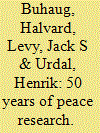

|
|
|
|
|
| Publication |
2014.
|
| Summary/Abstract |
Established in 1964, the Journal of Peace Research (JPR) celebrates 50 years. This anniversary special issue of the journal offers broad reviews of research areas that have been central both to the journal and to the field of peace and conflict research generally. An opening article co-authored by long-time editor Nils Petter Gleditsch offers a historical view on peace research and tracks trends in the use of 'peace' and 'violence' in titles of JPR across the first 49 volumes of the journal. Opening the review article section, two contributions address key thematic areas for the journal. Few if any subjects have attracted more attention in the study of international relations during the second half of JPR's first 50 years than the democratic peace, and in the extension of this subject, the broader debate about the liberal peace. Additional articles review the status and propose future developments in the study of war and its relationship with territory, ethnicity, ideology and natural resources. Another key historical topic associated with the journal concerns the economic cost of military conflict, while more recent research fields covered include terrorism and human rights, topics that have grown to become major JPR niches. Reflecting the methodological contributions by JPR, two articles focus on challenges of contemporary quantitative political analysis and progress in peace and conflict data collection. Finally, this special issue includes a review of research on international mediation in armed conflicts.
|
|
|
|
|
|
|
|
|
|
|
|
|
|
|
|
| 2 |
ID:
178671
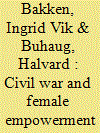

|
|
|
|
|
| Summary/Abstract |
Recent research has directed attention to the transformative potential of war for female empowerment. As a disruptive shock, armed conflict can create a window of opportunity for advancing the societal role of women. We complement this research agenda by looking at how conflict severity and termination condition the outcomes for women in the aftermath of civil conflict. We expect that both level of violence and mode of resolution affect subsequent female empowerment, where severe conflicts ending by a negotiated settlement have the greatest transformative potential. Consistent with expectations, we find that post-conflict improvements in female empowerment occur primarily after high-intensity civil conflicts. However, subsequent tests reveal that this effect is driven largely by conflicts terminated by peace agreements. The greatest improvement in female empowerment is seen when peace agreements have gender-specific provisions. These results support calls for a sustained effort toward mainstreaming gender issues in conflict resolution and peacebuilding processes.
|
|
|
|
|
|
|
|
|
|
|
|
|
|
|
|
| 3 |
ID:
108842
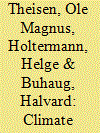

|
|
|
|
|
| Publication |
2011-12.
|
| Summary/Abstract |
Dominant climate models suggest that large parts of Africa will experience greater climatic variability and increasing rates of drought in coming decades. This could have severe societal consequences, because the economies and food supplies of most African countries depend on rain-fed agriculture. According to leading environmental security scholars, policymakers, and nongovernmental organizations, an increase in scarcity-driven armed conflicts should also be expected. A conditional theory of environmental conflict predicts that drought increases the risk of civil war primarily when it strikes vulnerable and politically marginalized populations in agrarian societies. However, an empirical evaluation of this general proposition through a unique gridded dataset of postcolonial Africa, which combines high-resolution meteorological data with georeferenced data on civil war onset and the local ethnopolitical context, shows little evidence of a drought-conflict connection. Instead, the local risk of civil war can be explained by sociopolitical and geographic factors: a politically marginalized population, high infant mortality, proximity to international borders, and high local population density.
|
|
|
|
|
|
|
|
|
|
|
|
|
|
|
|
| 4 |
ID:
082462
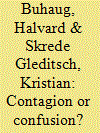

|
|
|
|
|
| Publication |
2008.
|
| Summary/Abstract |
Civil wars cluster in space as well as time. In this study, we develop and evaluate empirically alternative explanations for this observed clustering. We consider whether the spatial pattern of intrastate conflict simply stems from a similar distribution of relevant country attributes or whether conflicts indeed constitute a threat to other proximate states. Our results strongly suggest that there is a genuine neighborhood effect of armed conflict, over and beyond what individual country characteristics can account for. We then examine whether the risk of contagion depends on the degree of exposure to proximate conflicts. Contrary to common expectations, this appears not to be the case. Rather, we find that conflict is more likely when there are ethnic ties to groups in a neighboring conflict and that contagion is primarily a feature of separatist conflicts. This suggests that transnational ethnic linkages constitute a central mechanism of conflict contagion
|
|
|
|
|
|
|
|
|
|
|
|
|
|
|
|
| 5 |
ID:
083135
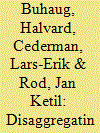

|
|
|
|
|
| Publication |
2008.
|
| Summary/Abstract |
Contemporary conflict research usually measures the influence of ethnicity on conflict by capturing ethnic constellations as country-based indices, such as ethnic fractionalization or polarization. However, such aggregated measures are likely to conceal the actual operation of actor-specific mechanisms. In this article, therefore, we introduce a disaggregated model that measures ethnic groups' access to power. We do so by disaggregating both ethnicity and conflict to the level of explicitly geo-coded center-periphery dyads. This procedure allows us to measure the power balance between politically excluded ethnic groups and dominant actors in terms of group sizes, distances between the center and the periphery, and the roughness of the latter's terrain. We rely on geographic information systems (GIS) to compute demographic and ethno-geographic variables. The dyadic analysis enables us to show that exclusion of powerful ethnic minorities increases the likelihood of conflict considerably. In addition, we show that the risk of conflict is positively associated with the extent of rough terrain in the peripheral group's home region and its distance from the political center
|
|
|
|
|
|
|
|
|
|
|
|
|
|
|
|
| 6 |
ID:
110808
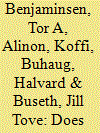

|
|
|
|
|
| Publication |
2012.
|
| Summary/Abstract |
While climate change scenarios for the Sahel vary and are uncertain, the most popularized prediction says there will progressively be drier conditions with more erratic rainfall. According to some, an increase in violent conflicts over scarce resources should also be expected. This article investigates the climate-conflict nexus in detail, focusing on a distinct area at the heart of the Sahel, the inland delta of the Niger river in the Mopti region of Mali. Two complementary analytical approaches are applied. The first consists of collection and analysis of court data on land-use conflicts, 1992-2009, from the regional Court of Appeal in Mopti. A comparison of the conflict data with statistics on contemporaneous climatic conditions gives little substance to claims that climate variability is an important driver of these conflicts. Second, we carried out a qualitative analysis of one of the many land-use conflicts in the region. Again, we find that factors other than those directly related to environmental conditions and resource scarcity dominate as plausible explanations of the violent conflict. We argue that three structural factors are the main drivers behind these conflicts: agricultural encroachment that obstructed the mobility of herders and livestock, opportunistic behavior of rural actors as a consequence of an increasing political vacuum, and corruption and rent seeking among government officials.
|
|
|
|
|
|
|
|
|
|
|
|
|
|
|
|
| 7 |
ID:
090989
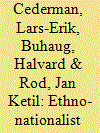

|
|
|
|
|
| Publication |
2009.
|
| Summary/Abstract |
Previous quantitative research on ethnic civil war relies on macro-level proxies in an attempt to specify the conditions under which ethnic minorities rebel. Going beyond an exclusive focus on minorities, the present study employs Geographic Information Systems (GIS) as a way to model ethnic center-periphery dyads that confront governments with excluded groups. We construct and analyze a new dataset of geo-referenced politically relevant ethnic groups, covering the entire world during the period from 1951 through 2005. Our results show that the conflict probability of marginalized groups increases with the demographic power balance compared to the group(s) in power. Furthermore, the risk of conflict increases with the distance from the group to the capital, and the roughness of the terrain in the group's settlement area. We also find that while the results for demographic group strength hold for all ethnic civil wars, the geographic factors apply for territorial ethnic conflicts only.
Previous quantitative research on ethnic civil war relies on macro-level proxies in an attempt to specify the conditions under which ethnic minorities rebel. Going beyond an exclusive focus on minorities, the present study employs Geographic Informat
|
|
|
|
|
|
|
|
|
|
|
|
|
|
|
|
| 8 |
ID:
090993


|
|
|
|
|
| Publication |
2009.
|
| Summary/Abstract |
Why do some armed civil conflicts last longer than others? Drawing on a contest success function model, we show that geographic factors (such as location, terrain, and natural resources) interact with rebel fighting capacity and together play a crucial role in determining the duration of conflict. Using precisely dated duration data in event history models and geographic data for the conflict location, we find that conflicts located at considerable distance from the main government stronghold, along remote international borders and in regions with valuable minerals last substantially longer. In addition, we find that rebel military capacity in its own right increases the prospects of a civil conflict ending within a short time period. Our findings imply that the distances an army must travel to project power, rebel fighting capacity, and characteristics of conflict region affect how a civil war is fought and who will prevail.
|
|
|
|
|
|
|
|
|
|
|
|
|
|
|
|
| 9 |
ID:
090998
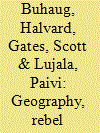

|
|
|
|
|
| Publication |
2009.
|
| Summary/Abstract |
Why do some armed civil conflicts last longer than others? Drawing on a contest success function model, we show that geographic factors (such as location, terrain, and natural resources) interact with rebel fighting capacity and together play a crucial role in determining the duration of conflict. Using precisely dated duration data in event history models and geographic data for the conflict location, we find that conflicts located at considerable distance from the main government stronghold, along remote international borders and in regions with valuable minerals last substantially longer. In addition, we find that rebel military capacity in its own right increases the prospects of a civil conflict ending within a short time period. Our findings imply that the distances an army must travel to project power, rebel fighting capacity, and characteristics of conflict region affect how a civil war is fought and who will prevail
|
|
|
|
|
|
|
|
|
|
|
|
|
|
|
|
| 10 |
ID:
137750
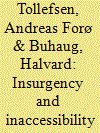

|
|
|
|
|
| Summary/Abstract |
A widely held belief within policy and practice contends that rough terrain and other physical obstacles to power projection hinder public surveillance, lower counterinsurgency capability, and generally constitute an important facilitator of rebellion. Likewise, sociocultural exclusion and alienation from the core are widely assumed to increase latent conflict risk through their influence on identity formation and perception of collective grievances. However, there is no scientific consensus on the empirical strength or significance of such a relationship, and many quantitative studies fail to find a robust link between a country's geographical or ethno-demographic characteristics and its estimated conflict risk. This paper represents a first comprehensive evaluation of how physical and sociocultural inaccessibility relate to contemporary civil wars. Drawing on recent advances in geographic information systems and georeferenced indicators of terrain, settlement patterns, ethno-political status, and armed conflict, we put the purported causal relationship to empirical test. A statistical analysis of civil-conflict events across post-Cold War Africa gives considerable support to the proposed theoretical framework, revealing that the various dimensions of inaccessibility all exert significant and substantive effects on local conflict risk. We find weaker evidence for the notion of substitutability; the inaccessibility indicators largely retain their individual effects when included in the same regression model.
|
|
|
|
|
|
|
|
|
|
|
|
|
|
|
|
| 11 |
ID:
107971
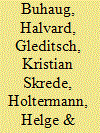

|
|
|
|
|
| Publication |
2011.
|
| Summary/Abstract |
Income varies considerably within countries and the locations where conflicts emerge are rarely typical or representative for states at large. Yet, most research on conflict has only examined national income averages and neglected spatial variation. The authors argue that civil conflicts are more likely to erupt in areas with low absolute income, even if a country's gross domestic product (GDP) per capita is not necessarily low, and in areas with large deviations from national averages. The authors test these hypotheses empirically using spatially disaggregated data on the location of conflict outbreaks and per capita income estimates. The authors find that areas with absolute poverty indeed see more outbreaks of conflict, and they find some evidence that inequality increases the risk of conflict. Subnational information can improve on conventional country-based measures and help our understanding of how local features and variation can give rise to mobilization and violence.
|
|
|
|
|
|
|
|
|
|
|
|
|
|
|
|
| 12 |
ID:
137786
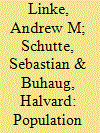

|
|
|
|
|
| Summary/Abstract |
One of the most powerful predictors of violent political conflict is proximate violence in space and time. This spatiotemporal pattern has been identified between countries as well as within them. What explains this clustering is less clear, and different studies point to different mechanisms. Focusing on sub-Saharan African states, we examine whether population attitudes may contribute to the spread of political violence at subnational scales. In a quasi-experimental research design—using georeferenced survey data of 18,508 respondents for 162 administrative units across 16 countries, paired with precisely georeferenced conflict event data—we find that popular acceptance of (the legitimacy of) the use of physical violence is positively associated with subsequent conflict events. Furthermore, the combined effect of nearby violence and approval of violence is stronger than either condition alone, implying a diffusion effect. While we find some evidence that conflict events affect later public opinion, our final models control for violence that occurred before the survey data were gathered. The fact that we include such violence in our analysis suggests that the reported results cannot be dismissed as merely reflecting a reverse causal relationship.
|
|
|
|
|
|
|
|
|
|
|
|
|
|
|
|
| 13 |
ID:
112782
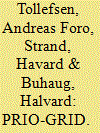

|
|
|
|
|
| Publication |
2012.
|
| Summary/Abstract |
Contributions to the quantitative civil war literature increasingly rely on geo-referenced data and disaggregated research designs. While this is a welcome trend, it necessitates geographic information systems (GIS) skills and imposes new challenges for data collection and analysis. So far, solutions to these challenges differ between studies, obstructing direct comparison of findings and hampering replication and extension of earlier work. This article presents a standardized structure for storing, manipulating, and analyzing high-resolution spatial data. PRIO-GRID is a vector grid network with a resolution of 0.5 x 0.5 decimal degrees, covering all terrestrial areas of the world. Gridded data comprise inherently apolitical entities; the grid cells are fixed in time and space, they are insensitive to political boundaries and developments, and they are completely exogenous to likely features of interest, such as civil war outbreak, ethnic settlement patterns, extreme weather events, or the spatial distribution of wealth. Moreover, unlike other disaggregated approaches, gridded data may be scaled up or down in a consistent manner by varying the resolution of the grid. The released dataset comes with cell-specific information on a large selection of political, economic, demographic, environmental, and conflict variables for all years, 1946-2008. A simple descriptive data assessment of population density and economic activity is offered to demonstrate how PRIO-GRID may be applied in quantitative social science research.
|
|
|
|
|
|
|
|
|
|
|
|
|
|
|
|
| 14 |
ID:
076107
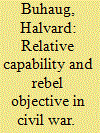

|
|
|
| 15 |
ID:
178643
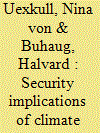

|
|
|
|
|
| Summary/Abstract |
The study of security implications of climate change has developed rapidly from a nascent area of academic inquiry into an important and thriving research field that traverses epistemological and disciplinary boundaries. Here, we take stock of scientific progress by benchmarking the latest decade of empirical research against seven core research priorities collectively emphasized in 35 recent literature reviews. On the basis of this evaluation, we discuss key contributions of this special issue. Overall, we find that the research community has made important strides in specifying and evaluating plausible indirect causal pathways between climatic conditions and a wide set of conflict-related outcomes and the scope conditions that shape this relationship. Contributions to this special issue push the research frontier further along these lines. Jointly, they demonstrate significant climate impacts on social unrest in urban settings; they point to the complexity of the climate–migration–unrest link; they identify how agricultural production patterns shape conflict risk; they investigate understudied outcomes in relation to climate change, such as interstate claims and individual trust; and they discuss the relevance of this research for user groups across academia and beyond. We find that the long-term implications of gradual climate change and conflict potential of policy responses are important remaining research gaps that should guide future research.
|
|
|
|
|
|
|
|
|
|
|
|
|
|
|
|
| 16 |
ID:
133656
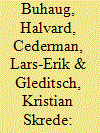

|
|
|
|
|
| Publication |
2014.
|
| Summary/Abstract |
Much of the recent research on civil war treats explanations rooted in political and economic grievances with considerable suspicion and claims that there is little empirical evidence of any relationship between ethnicity or inequality and political violence. We argue that common indicators used in previous research, such as the ethno-linguistic fractionalization (ELF) and the Gini coefficient for income dispersion, fail to capture fundamental aspects of political exclusion and economic inequality that can motivate conflict. Drawing on insights from group-level research, we develop new country-level indices that directly reflect inequalities among ethnic groups, including political discrimination and wealth differentials along ethnic lines. Our analysis reveals that these theoretically informed country profiles are much better predictors of civil war onset than conventional inequality indicators, even when we control for a number of alternative factors potentially related to grievances or opportunities for conflict.
|
|
|
|
|
|
|
|
|
|
|
|
|
|
|
|
| 17 |
ID:
190886
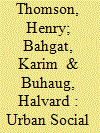

|
|
|
|
|
| Summary/Abstract |
The world’s population is increasingly concentrated in cities. Research on urbanization’s implications for peace and security has been hampered by a lack of comparable data on political mobilization and violence at the city level across space and through time, however. Urban Social Disorder 3.0 is a detailed event dataset covering 186 national capitals and major urban centers from 1960 to 2014. It includes 12 types of nonviolent and violent events, detailing the actors involved and their targets, start and end dates of each event, and the number of participants and deaths. We provide an overview of the main features of these data, and trends in urban social disorder across space and time. We demonstrate the utility of the dataset by analyzing the relationship between city size and the frequency of lethal disorder events. We find a positive relationship between city population and lethal urban social disorder, unlike previous studies. These new data raise promising avenues for future research on democratization; climate change and food security; and spillovers between different forms of mobilization and violence.
|
|
|
|
|
|
|
|
|
|
|
|
|
|
|
|
|
|
|
|
|